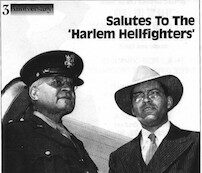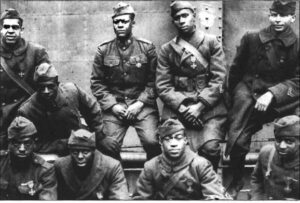Salutes to the Harlem Hellfighters |1994-2

Hon. Truman Gibson, Ass’t to the Secretary of War For Negro Affairs (1944)
For 81 years, New York City’s own Harlem Hellfighters have served both State and Nation as Citizen-soldiers, all while fighting the harder and longer battle for civil rights. Here is the story of this famous African-American regiment from Harlem.
Formation of the Regiment of Colored Infantry
Until 1913, black Americans were denied the right to serve in the National Guard of New York State, but after many months of urging by the Lenox Community Council, Governor Charles C. Whitman finally authorized the formation of a Regiment of Colored Infantry in the New York National Guard, appointing a white attorney, Colonel William Hayward, as the first commander.

Community Response and Initial Drilling
The response from New York City’s black community was overwhelming, and soon, volunteers were flocking to join at the disused dance hall on 7th Avenue and 132nd Street that served as this unit’s Armory. The volunteers drilled there, or at Camp Harlem — the city’s streets and parks. In 1916, the 15th Regiment of Colored Infantry of the N.Y. National Guard was formally accepted into the State’s Organized Militia forces, and presented with its own flag.
Acceptance for Wartime Service
By 1917, it was up to full strength and was accepted for wartime service after the United States’ declaration of war.
Challenges and Training
The Harlem Hellfighters requested assignment to the 42nd Rainbow Division, but was curtly told that “black is not a color of the rainbow.” While unassigned to a division, they left for training in Spartanburg, South Carolina, where the unit’s New York troopers had to deal with the South’s harsh Jim Crow system.
Deployment to France
In late 1917, the unit went to Hoboken and embarked for France in December; after three shipwrecks, it finally made it overseas, still carrying its State flag, still designated as the 15th New York [instead of receiving a Federal number].
Combat and Recognition in France
Although in France, the 15th was still not freed from American racism; the segregationist U.S. Army opposed black combat units, feeling that African-Americans lacked the ability to fight. Accordingly, they assigned this proud unit to labor duties. After numerous protests, General John J. Pershing finally assigned them to combat duties — but with the French Army! Re-designated as the 369th U.S. Infantry, the Harlem Hellfighters began training with their French comrades, discovering to their delight that the French drew no color line.
Praise and Honors

Despite the misgivings of U.S. generals about blacks’ ability in combat, the 369th immediately began to run up one of the finest records in the American Expeditionary Force. The first Croix de Guerre — a high French decoration awarded to any American — went to two soldiers of the 369th, Cpl. Henry Johnson and Pvt. Needham Roberts, who, although wounded, single-handedly fought off a determined attack by over 25 Germans. French leaders also praised the unit in no uncertain terms: “Experience in recent battles has shown that the bravery of all, officers and men, was admirable and worthy of the highest praise…”
Musical Influence and Return to New York
The Harlem Hellfighters also gained fame for their regimental band which introduced jazz to European audiences and set a taste for this music that still remains today. Led by Lt. James Reese Europe, a famous band leader, composer, and arranger, the band included such well-known musicians as Noble Sissle and Frank DeBroit in its ranks. Detached from the unit, it toured all of France at the personal request of Supreme Allied Commander Marshal Foch, delighting audiences with this new style in original American music.
Post-World War I Developments
Led by its Band, the unit returned to New York in late 1918 and, in 1919, was consolidated with the 15th of the New York Guard that had taken its place while it had gone abroad. It returned to its original number, the 15th, and by 1920 had seen the completion of its own Armory, between 142nd and 143rd Streets and Lenox and Fifth Avenues.
Service in World War II
In 1940, the 369th was called to active duty and converted to a Coast Artillery Anti-Aircraft Regiment, under the command of Col. Chauncey A. Hooper. It then was sent to Hawaii, its place back home being taken by the 15th Regiment of the N.Y. Guard. In the Pacific Theatre, the 369th was split into the 369th Anti-Aircraft Battalion, the 870th Anti-Aircraft Battalion, and the 726th Searchlight Battery, and again distinguished itself, especially at Okinawa, where the gunners of the 870th fought as infantry against determined Japanese attacks.
Local Defense and Korean War
Back in the States, the 15th, commanded by Col. W. Woodruff Chisum, performed various local defense and security duties. In 1950, the 369th Anti-Aircraft was again called to active duty for the Korean War, serving stateside until 1952. After the Korean War, the 369th became a Field Artillery Group.
Modern Era and Contributions
In 1974, the Harlem Hellfighters were finally re-designated as the 369th Transportation Battalion of the N.Y. Army National Guard, and in 1990, became the first major N.Y. National Guard unit to be called up for Operation Desert Storm. The 369th’s Headquarters and its 719th and 1569th Transportation Companies served in Saudi Arabia, Kuwait, and Iraq, providing logistical services to the 18th U.S. Airborne Corps and to other combat units.
Recognition and Leadership Today
The 369th is now commanded by Lt. Col. Anthony Spencer, a civic and community leader. The 15th N.Y. Guard, now the 1st Battalion, 15th Regiment, N.Y. Guard, is commanded by Lt. Col. George Edwards.
Legacy and Future Focus
Over 80 years, the 369th and 15th Harlem Hellfighters have contributed significantly to the Free World, to the Nation, to the State, and to their Community. They were at the forefront of the battle for civil rights before it was known as such, and have seen many changes over the years. They have, since 1940, given no less than 17 generals to the State and Nation, focusing both on preparedness for war and their State mission, providing emergency help and humanitarian relief.
See the complete issue of ROUTES, A Guide to Black Entertainment May 24,1994 as PDF.
